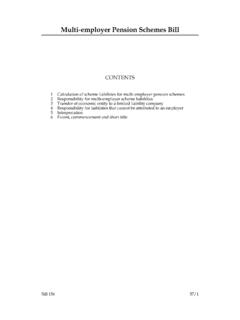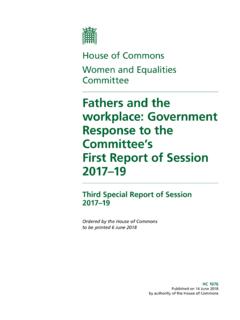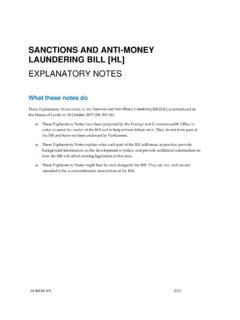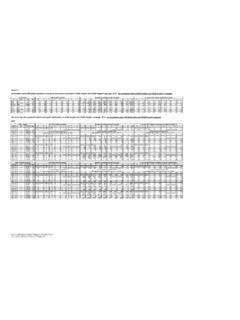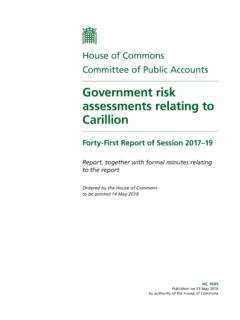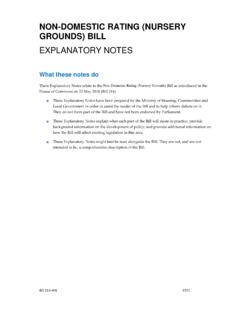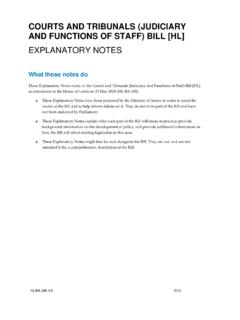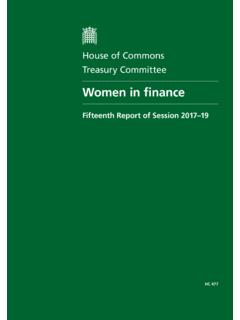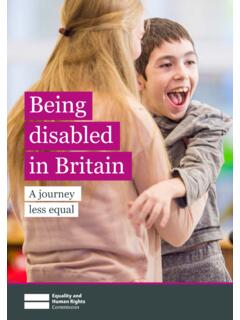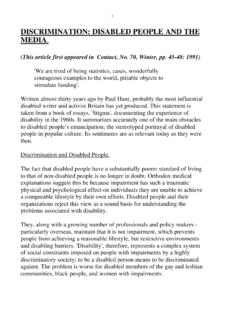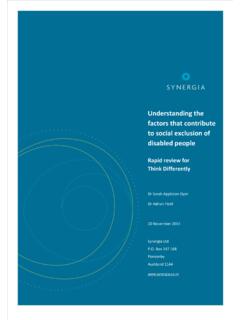Transcription of The Equality Act 2010: the impact on disabled people
1 Ordered to be printed 15 March 2016 and published 24 March 2016 Published by the Authority of the House of LordsLondon : The Stationery Office Limited priceHOUSE OF LORDSS elect Committee on the Equality Act 2010 and DisabilityReport of Session 2015 16 The Equality Act 2010: the impact on disabled peopleHL Paper 117 Select Committee on the Equality Act 2010 and DisabilityThe Select Committee on the Equality Act 2010 and Disability was appointed by the House of Lords on 11 June 2015 to consider the impact on people with disabilities of the Equality Act 2010. MembershipThe Members of the Select Committee on the Equality Act 2010 and Disability were:Baroness BrintonBaroness Jenkin of KenningtonBaroness BrowningLord McColl of DulwichBaroness Campbell of SurbitonLord NorthbrookBaroness Deech (Chairman)Baroness PitkeathleyLord Faulkner of WorcesterBaroness Thomas of WinchesterLord Foster of Bishop Auckland (from 9 July 2015)Baroness Wilkins (resigned 9 July 2015)Lord HarrisonDeclaration of interestsSee Appendix full list of Members interests can be found in the Register of Lords Interests: publications of the Committee are available at: Parliament LiveLive coverage of debates and public sessions of the Committee s meetings are available at.
2 InformationFurther information about the House of Lords and its Committees, including guidance to witnesses, details of current inquiries and forthcoming meetings is available at: staffThe staff who worked on this Committee were Michael Collon (Clerk), Tansy Hutchinson (Policy Analyst), Andrew Woollatt (Committee Assistant) and Joseph Coley (Committee Assistant).Contact detailsAll correspondence should be addressed to the Select Committee on the Equality Act 2010 and Disability, Committee Office, House of Lords, London SW1A 0PW. Telephone 020 7219 4384. Email Summary 5 Chapter 1: Introduction 7 Constitution and Terms of Reference of the Committee 7 The devolved administrations 8 Our working methods 9 Acknowledgements 10 Five major issues 10 The next steps 11 Chapter 2: The Background to the Equality Act 2010 12 Statistics and demographic changes: the scale of the problem 12 Table 1: Number of disabled people in Great Britain (millions) 12 Figure 1: Number of disabled people in Great Britain (millions) 13 Figure 2.
3 Male disability-free life expectancy at birth, 2005 07 and 2008 10 14 Figure 3: Female disability-free life expectancy at birth, 2005 07 and 2008 10 14 Figure 4: Disability-free life expectancy at birth for men in England by region, 2009 11 and 2012 14 15 Figure 5: Disability-free life expectancy at birth for women in England by region, 2009 11 and 2012 14 15 Figure 6: Proportion in age groups reporting a long-term limiting illness or disability in 2001 and 2011 16 Figure 7: Numbers in age groups reporting a long-term limiting illness or disability in 2001 and 2011 16 Table 2: Life expectancy and disability-free life expectancy at age 65 17 Figure 8: Life expectancy and disability-free life expectancy at age 65, 2000 2011 17 Development of the substantive law 18 Oversight of the law 19 The Equality Act 2010 19 Disability: the poor relation?
4 21 The medical and social models of disability 23 Different disabilities 24 Definition of disability 25 Provisions not in force 25 Part 1: Socio-Economic Inequalities 25 Section 14: Combined discrimination: dual characteristics 25 Section 36(1)(d): Reasonable adjustments for common parts of premises 25 Part 12, Chapter 1: Transport of disabled persons by taxi 25 The Equalities Red Tape Challenge 26 Box 1: The Red Tape Challenge 26 The UN Convention on the Rights of Persons with Disabilities 26 Incorporation of the Convention into UK law 29 The Protocol to the UNCRPD 31 European Union Law: the draft Directive on Accessibility 31 CONTENTSPageChapter 3: Oversight and Advice 33 Oversight within Government 33 Box 2: Main government departments responsible for disability issues 33 Who is policing the Act in Government?
5 34 Developing effective cross government policy and strategy 35 The Equality and Human Rights Commission 38 The Disability Rights Commission 38 Role, duties and powers of the Equality and Human Rights Commission 39 Box 3: Powers of the Equality and Human Rights Commission 40 Effectiveness 40 Resources 43 The Disability Committee 44 The Equality Advisory and Support Service 46 Box 4: The Disability Rights Commission helpline in action 48 Codes of Practice 48 Chapter 4: Communication and Language 51 Accessible communications and information 51 British Sign Language 52A BSL Act 53 The need for communication in BSL 54 Our conclusion 55 Promoting awareness and understanding of the Equality Act, rights and remedies 55 Awareness or understanding?
6 55 Regaining the independent living narrative 56 Public awareness and education 56 Chapter 5: Reasonable Adjustment 59 Box 5: The Reasonable Adjustment Duty 59 Awareness and understanding of the duty to make reasonable adjustments 62 Awareness of the anticipatory duty 62 Understanding the reasonable adjustment concept 63 Clarity versus flexibility and the cost factor 64 Clarity 64 Flexibility 65 Cost 66 Code of Practice and guidance 69 Common
7 Parts 71 Sports grounds 73 Chapter 6: Carers 75 The position of carers under the Equality Act 75 Discrimination and Carers 75 Protection under the Equality Act 2010 76 Discrimination by association 76 Box 6: Coleman v Attridge Law 77 The duty to make reasonable adjustments 77 Carers and indirect discrimination 78 The rights of carers outside the Equality Act 78 Flexible working in employment 78 Box 7: What is the right to request flexible working? 78 Existing rights to support: the Care Act 79 Chapter 7: Transport 80 Introduction 80 Box 8: Travel by train for a wheelchair user 80 Trains: infrastructure and accessibility 81 Bus travel 82 Audio-visual annunciators 83 Retrofitting 84 Training for bus and train staff 85Ta x i s 8 6 The provisions of the Act 87 The failure to commence section 165 87 Training of taxi drivers 89 Local transport problems 89 Shared spaces 90 Chapter 8: The Public Sector Equality Duty 93 Box 9.
8 The General Duty 94 Process or outcomes 95 Box 10: Due regard in the case law 95 The specific duties 99 Box 11: The English Specific Duties 100 The unspecific duties? 100 Wales and Scotland 102 Cumulative impact assessment 103 Box 12: What is cumulative impact assessment? 104Is cumulative impact assessment possible? 105 Box 13: Feasibility of cumulative impact assessment 105 Government review 107 Chapter 9: Enforcement through the judicial process 108 Introduction 108 Tribunal fees 108 Figure 9: Disability discrimination claims received by employment tribunals 109 The deterrent effect of costs 111 Qualified one-way costs shifting (QOCS) 113 The statutory questionnaire 114 Box 14: The statutory questionnaire procedure 115 Tribunals powers to make wider recommendations 116 Remedies in the courts 117 Injunctive relief 119 Intervention by the EHRC 119 Class actions 120 Box 15.
9 Draft EU Accessibility Directive, Article 25 121 Dual discrimination 122 The fact or degree of disability 122 Reforms of the civil courts 123 Chapter 10: Other remedies for discrimination 124 Introduction 124 Conciliation and mediation 124A Disability Ombudsman? 125 The Powers of Local Authorities 128 Licensed premises 128 Box 16: Licensing Act 2003, section 4 129 Enforcement of the taxi provisions by licensing authorities 130 The built environment 132 Box 17: Building Regulations, Approved Document M, 2013 edition 133 Summary 135 Chapter 11: disabled children and children with special educational needs 136 Educational attainment 136 Accessing rights under the Equality Act: Definition of disability 137 Box 18.
10 Example changes that a school can make to support positive behaviour in the classroom 138 Proactive inspection and enforcement: the role of Ofsted 138 Chapter 12: Participation in politics 140 Summary of Conclusions and Recommendations 143 Appendix 1: List of Members and Declarations of Interest 149 Appendix 2: List of Witnesses 151 Appendix 3: Call for Evidence 159 Appendix 4: Note of visit to Real 161 Appendix 5: Recommendations requiring legislative changes 166 Appendix 6: Acronyms 168 Evidence is published online at available for inspection at the Parliamentary Archives (020 7129 3074).Q in footnotes refers to a question in oral Equality ACT 2010: THE impact ON disabled PEOPLESUMMARYI ntroductionThere are over 11 million disabled people in the United Kingdom, and the number grows year by year.

